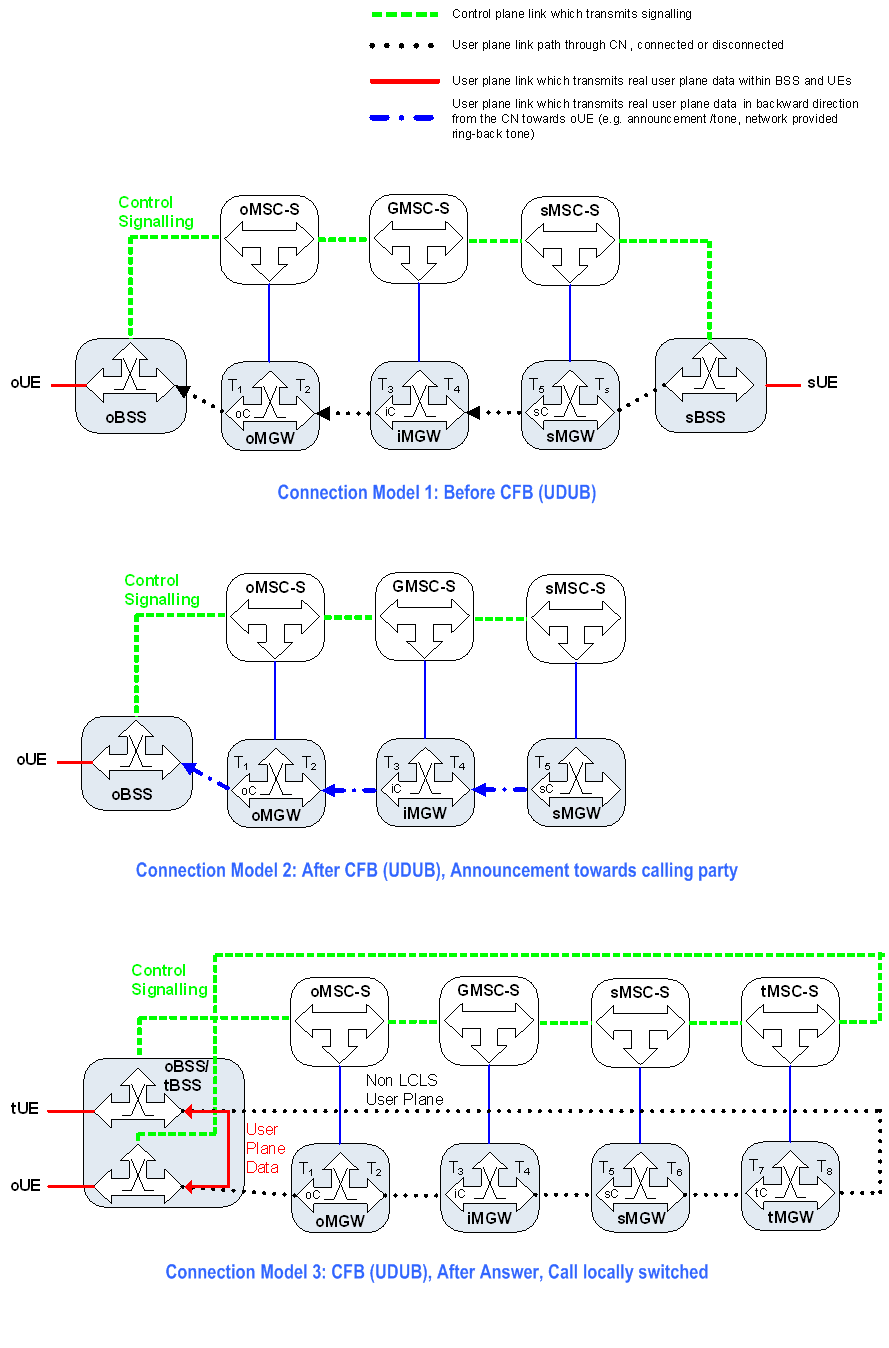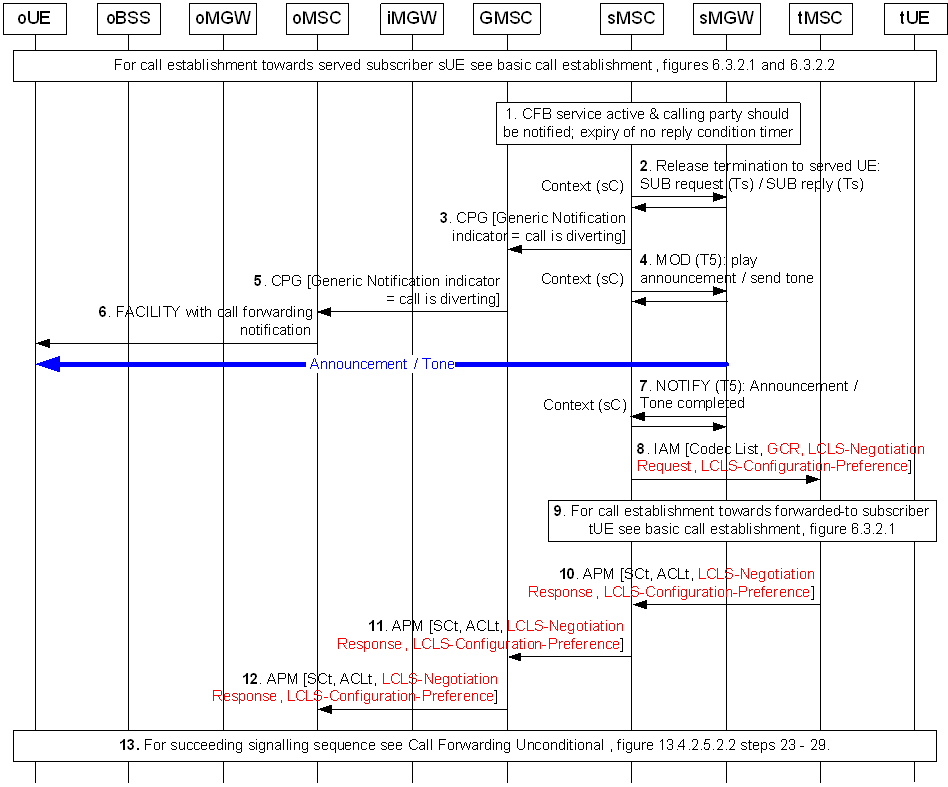Content for TS 23.284 Word version: 18.0.0
1…
4…
4.2…
4.3…
5
6…
6.3…
6.3.2
6.3.3
6.3.4
6.3.5
7…
7.2.4…
7.2.4.2
7.2.4.3
7.2.4.4
7.2.4.5
7.2.4.6
7.3…
7.3.4…
7.3.4.2
7.3.4.3
7.3.4.4
8…
8.2.3
8.3…
8.3.2
8.4…
8.4.1.1.7…
8.4.1.2…
8.4.2…
8.4.2.2…
8.4.5…
8.4.5.6
8.4.5.7
8.4.5.8…
9…
13…
13.4…
13.4.3…
13.4.4…
13.5…
13.6…
13.7…
14…
16…
A…
A.2…
13.4.3 Call Forwarding on mobile subscriber Busy (CFB)
13.4.3.1 Network Determined User Busy (NDUB)
13.4.3.1.1 General
13.4.3.1.2 Notification to the Calling Subscriber
13.4.3.1.3 Initial Addressing
13.4.3.1.4 Backward LCLS Negotiation
13.4.3.1.5 LCLS Through-Connection
13.4.3.1.6 Example
13.4.3.2 User Determined User Busy (UDUB)
13.4.3.2.1 General
13.4.3.2.2 Call Clearing to the Served Subscriber
13.4.3.2.3 Notification to the Calling Subscriber
13.4.3.2.4 Initial Addressing
13.4.3.2.5 Backward LCLS Negotiation
13.4.3.2.6 LCLS Through-Connection
13.4.3.2.7 Example
13.4.3.2.7.1 Connection Model
13.4.3.2.7.2 Basic Sequence
...
...
13.4.3 Call Forwarding on mobile subscriber Busy (CFB) p. 142
13.4.3.1 Network Determined User Busy (NDUB) p. 142
13.4.3.1.1 General p. 142
The incoming call that meets mobile subscriber busy with the condition Network Determined User Busy (NDUB) shall be forwarded towards the forwarded-to subscriber without being offered to the served mobile subscriber. The basic call establishment procedures defined in the clause 6 shall be followed for the call towards the forwarded-to subscriber.
13.4.3.1.2 Notification to the Calling Subscriber p. 142
If the GMSC server determines that a call should be forwarded without being offered to the served mobile subscriber and the served mobile subscriber has requested that the calling subscriber shall receive a notification about the call forwarding, the GMSC server shall send a notification to the preceding node. If the GMSC server supports the LCLS feature and receives the GCR IE, the LCLS-Negotiation Request IE and LCLS-Configuration-Preference IE from the preceding node it may modify the LCLS-Configuration-Preference IE based on its own LCLS configuration requirements, as described in clause 4.2, and it shall return the resulting LCLS-Configuration-Preference IE and the LCLS-Negotiation Response IE to the preceding node.
If the notification is implemented using intermediate tones or announcements the GMSC server requests the MGW to play an announcement/tone to the calling party, as described in clause 14.6, before establishing the call to the forwarded-to subscriber.
13.4.3.1.3 Initial Addressing p. 143
If the incoming call is to be forwarded without being offered to the served mobile subscriber the call towards the forwarded-to subscriber is established as for a basic call. After the possible generation of in-band information has been completed the initial addressing towards the forwarded-to subscriber is performed as described in the clause 6 for the basic mobile terminating call. If the GMSC server supports the LCLS feature and receives the GCR IE, the LCLS-Negotiation Request IE and LCLS-Configuration-Preference IE from a preceding node in the IAM it shall forward the GCR IE and the resulting LCLS-Configuration-Preference IE and the LCLS-Negotiation Request IE to the succeeding node.
13.4.3.1.4 Backward LCLS Negotiation p. 143
The procedure specified in clause 6.2.1.2.2 for the intermediate node and in clause 6.1.1.4 for the oMSC server shall be applied.
13.4.3.1.5 LCLS Through-Connection p. 143
The procedure specified in clause 6.1.1.5 shall be applied.
13.4.3.1.6 Example p. 143
The same example as for Call Forwarding Unconditional applies.
13.4.3.2 User Determined User Busy (UDUB) p. 143
13.4.3.2.1 General p. 143
The incoming call shall be offered to the served subscriber as a normal call. When the call meets mobile subscriber busy with the condition User Determined User Busy (UDUB) it shall be forwarded towards the forwarded-to subscriber. The basic call establishment procedures defined in the clause 6 shall be followed for the call towards the forwarded-to subscriber.
13.4.3.2.2 Call Clearing to the Served Subscriber p. 143
When the MSC server determines that the call shall be forwarded due to the UDUB it shall release the call leg towards the served subscriber as described in the clause 7.1 for call clearing.
13.4.3.2.3 Notification to the Calling Subscriber p. 143
If the MSC server determines that a call should be forwarded and the served mobile subscriber has requested that the calling subscriber shall receive a notification about the call forwarding, the MSC server shall send a notification to the preceding node.
If the notification is implemented using intermediate tones or announcements the MSC server requests the MGW to play an announcement/tone to the calling party, as described in clause 14.6, before establishing the call to the forwarded-to subscriber.
13.4.3.2.4 Initial Addressing p. 143
If the incoming call is to be forwarded the call towards the forwarded-to subscriber is established as for a basic call. After the possible generation of in-band information has been completed the initial addressing towards the forwarded-to subscriber is performed as described in the clause 6 for the basic mobile terminating call. If the forwarding MSC server supports the LCLS feature and has received the GCR IE, the LCLS-Negotiation Request IE and LCLS-Configuration-Preference IE from a preceding node in the IAM it shall then forward the GCR IE and the resulting LCLS-Configuration-Preference IE and the LCLS-Negotiation Request IE to the succeeding node.
13.4.3.2.5 Backward LCLS Negotiation p. 144
The procedure specified in clause 6.2.1.2.2 for the intermediate node and in clause 6.1.1.4 for the oMSC server shall be applied.
13.4.3.2.6 LCLS Through-Connection p. 144
The procedure specified in clause 6.1.1.5 shall be applied.
13.4.3.2.7 Example p. 144
13.4.3.2.7.1 Connection Model p. 144
Figure 13.4.3.2.7.1.1 shows the network model for call forwarding busy UDUB.
The oMSC server seizes one context with two bearer terminations in the oMGW. The bearer termination T1 is used for the bearer towards the oBSS (calling subscriber) and the bearer termination T2 is used for the bearer towards the GMSC selected iMGW. The GMSC server seizes one context with two bearer terminations in the iMGW. The bearer termination T4 is used for the bearer towards the sMSC server selected sMGW and the bearer termination T3 is used for the bearer towards the preceding oMGW. The sMSC server seizes one context with two bearer terminations in the sMGW. The bearer termination T5 is used for the bearer towards the GMSC selected iMGW and bearer termination Ts is used for the bearer towards the sBSS (served subscriber).
After call forwarding busy UDUB is detected the sMSC server replaces the bearer termination for the served mobile subscriber Ts with the bearer termination for the forwarded-to subscriber T6 in an existing context in the sMGW.
The tMSC server seizes one context with two bearer terminations in the tMGW. The bearer termination T7 is used for the bearer towards the sMSC selected sMGW and bearer termination T8 is used for the bearer towards the tBSS (forwarded-to subscriber).

Figure 13.4.3.2.7.1.1: Connection Model for Call Forwarding Busy UDUB
(⇒ copy of original 3GPP image)
(⇒ copy of original 3GPP image)
13.4.3.2.7.2 Basic Sequence p. 145
Figure 13.4.3.2.7.2.1 shows the message sequence example for the call forwarding UDUB with a possible notification to the calling party using an announcement. In the example the sMSC server optionally requests the sMGW to play an announcement and to notify the announcement completion, after the bearer to the incoming side has been established. When the possible announcement has completed the sMSC server requests the establishment of the call and the bearer towards the forward-to subscriber. This example is based on examples from clause 6.

Step 1.
The sMSC server determines that call should be forwarded because of the Call Forwarding Busy UDUB supplementary service and that notification should be send towards the calling party (oUE).
Step 2.
The sMSC server orders the sMGW to remove the bearer termination (Ts) towards the served mobile subscriber (in case when the radio resources had already been allocated in the sMGW).
Step 3.
The sMSC server sends the CPG message with the Generic Notification Indicator parameter set to "Call is diverting".
Step 4.
The sMSC server provides the sMGW with the announcement/tone identification and requests the sMGW to notify the announcement/tone completion using the Play Announcement or Send Tone procedure.
Step 5.
The GMSC server sends the CPG message with the Generic Notification Indicator parameter set to "Call is diverting".
Step 6.
The oMSC server notifies the calling user (oUE) about call forwarding.
Step 7.
The sMGW notifies the sMSC server when the announcement/tone is completed using the Announcement Completed or Tone Completed procedure.
Step 8.
If the sMSC server supports LCLS it may modify the LCLS-Negotiation Request IE and the LCLS-Configuration-Preference IE before sending the IAM message containing the GCR with the encapsulated oBSS ID and the LCLS-Negotiation Request IE and the LCLS-Configuration-Preference IE.
Step 9.
When performing further call establishment towards the forwarded-to subscriber see clause 6 and the procedure specified for mobile originating call.
Step 10.
The tMSC server returns the APM message with the selected codec and if LCLS is supported, the LCLS-Negotiation Response IE and the LCLS-Configuration-Preference IE.
Step 11.
The sMSC server transfers the APM message with the LCLS-Negotiation Response IE and the LCLS-Configuration-Preference IE. If codec modification is required then the sMSC server includes the codec related information within the same APM message.
Step 12.
The GMSC server transfers the APM message.
Step 13.
When performing further call establishment see signalling sequence for Call Forwarding Unconditional, Figure 13.4.2.5.2.2, steps 23 - 29.